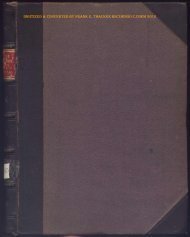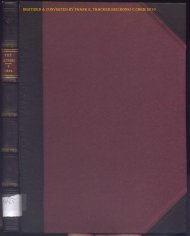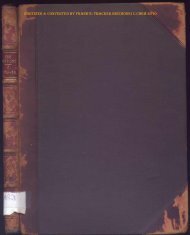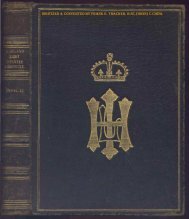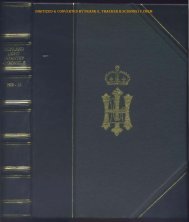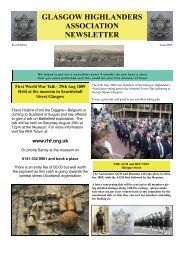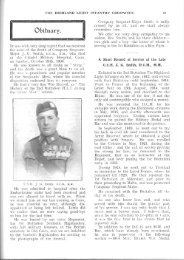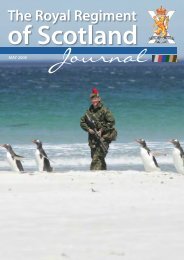Journal 2008 - The Journal Royal Highland Fusiliers - The Royal ...
Journal 2008 - The Journal Royal Highland Fusiliers - The Royal ...
Journal 2008 - The Journal Royal Highland Fusiliers - The Royal ...
Create successful ePaper yourself
Turn your PDF publications into a flip-book with our unique Google optimized e-Paper software.
Book Reviews<strong>The</strong> British Army – a pocket guide <strong>2008</strong>-2009 ed Charles Heyman(ISBN 978-1-84415-280-3 Pen & Sword Books Ltd, £5.99)Some might doubt whether a small book such as this merits a review,bearing as it does on its title page the important caveat that itscontents have been gathered from unclassified sources. Those whocare to read it are almost certain to dissent from that view.Running to a total of 231 pages, it begins with a detailed ContentsList of the items covered in its 14 chapters. Despite the small fontused of necessity, it is well laid out, easy to follow, and contains noserious typographical error that this reviewer could spot. <strong>The</strong> text issupported by numerous silhouettes of aircraft and vehicles currentlyin service. A select list of standard military abbreviations at the endof the book will prove handy, and not merely to those who (like thisreviewer?) merit the description of outdated old buffers.Towards the end of this worthwhile little book is a collectionof military and general quotations, commended to youngOfficers and NCOs as useful for briefings. Under the headingFinally, there is this gem, overheard at RMA Sandhurst: DrillInstructor to an embarrassed Officer Cadet who appears to becompletely incapable of identifying left from right – “Tell me,Sir, as an outsider, what is your opinion of the human race?”A S RCONFRONTATION – <strong>The</strong> War with Indonesia 1962-1966 byNick van der Bijl (ISBN 9781 8441 55958 Pen & Sword Books,2007, £19.99, but available more cheaply when ordered directvia the publisher’s website)<strong>The</strong> Brunei Revolt of December 1962, although led by localdissident/aspiring nationalist politician Azahari, had the undoubtedbacking of Indonesia. That revolt was swiftly and decisivelyquelled by 99th Gurkha Infantry Brigade flown out in haste fromSingapore. This consisted principally of the standby battalion (1stBn Queen’s Own <strong>Highland</strong>ers) and 1/2nd Gurkha Rifles and wasjoined a little later by ‘A’ Squadron 22 SAS and other key units.Immediately thereafter however the adjacent East Malaysian statesof Sabah (formerly the British Crown Colony of North Borneo) andSarawak (which the ‘White Rajahs’ of the Brooke family had ruled)both became the target of sustained Indonesian armed incursionsemploying both regular and irregular units, the latter in particularenjoying a good deal of succour from Communist elements withinthe ethnic Chinese population (which was especially large inSarawak). Defeating ‘Confrontation’ (a term derived directly fromthe Indonesian Konfrontasi) was to call for a long campaign in whichMalaysian, British and Commonwealth forces fought.<strong>The</strong> problem had been growing for some years. As far backas the 1950s, the activities of the Clandestine CommunistOrganisation (CCO) in Sabah had been a cause for concern, ashad more recently been those of the Sarawak United People’sParty in that State. Indonesia’s incursions thus had to be seen as aserious threat at least to the stability of Malaysia, if not to its veryexistence. Malaysia had only just been established, and Indonesia’sunpredictable President Achmed Sukarno, long nurturing hisstated ambition of extending Indonesian influence, had beenopenly hostile to the concept of Malaysia, branding it as a creatureof neo-colonial imperialism and repeatedly vowing to crush it.It was to be 11 August 1966, shortly after Sukarno’s fall frompower, before Indonesia’s more moderate leadership put afinal end to ‘Confrontation’. For the Malaysian, British andCommonwealth forces involved at sea, on land and in the air, thecampaign had been nothing short of de facto war, during whichmany awards for gallantry were won, including the 1965 VC byLCpl Rambahadur Limbu of 2/10GR. <strong>The</strong> clasp ‘Borneo’ was thefirst on the new General Service Medal. Casualties for the wholeperiod were 114 killed and 181 wounded, while civilians suffered36 killed, 53 wounded, and 4 captured. <strong>The</strong> Indonesian forces lostat least 590 killed, 222 wounded, and 771 captured.Recalling that at its height the theatre absorbed 17,000Commonwealth servicemen, with another 10,000 immediatelyavailable, there has been relatively little written about Confrontationaimed at general readership. <strong>The</strong> Undeclared War (Harold James &Denis Sheil-Small, Leo Cooper Ltd 1971, and later NEL paperback1973) is a good concise account, and there is of course How Borneowas Won, by General Sir Walter Walker himself, on whom Malaysiabestowed the title ‘Dato’, on a par with knighthood and rarelyconferred on foreigners. Copies of this monograph are hard to find.Nicholas van der Bijl BEM joined the Intelligence Corps in 1970 andserved for twenty years in a wide variety of postings. In Confrontation– <strong>The</strong> War with Indonesia, he has written a fine account which is wide inscope and unprecendented in depth, possibly the better for not havingserved in that campaign. Running, with Index, to 280 pages, it includesno fewer than 16 maps, 3 tables, 38 monochrome photographs, and abibliography. Conveniently placed towards the front is a usefulGlossary. In his Foreword, the Rt Hon Lord Denis Healey ofRiddlestone (Defence Secretary at the time) expresses his delight “thata detailed account of Britain’s confrontation with Indonesia has at lastbeen published. Our campaign was a text-book demonstration of howto apply economy of force, under political guidance, for political ends.”He rightly pays tribute to General Walter Walker, under whose overallcommand much of the campaign was conducted.To the best of this reviewer’s knowledge, two greatly-missedRHF friends served Staff tours of duty in the FARELF duringConfrontation: Robin Thorburn (Lt Col R E M Thorburn) and DonaldMack (Major D I A Mack), the former at HQ Director of BorneoOperations in Labuan, the latter at the subordinate HQ in Singapore,through which the majority of forces transited en route for Sabah andSarawak. A former Officer of the Regiment, the late John Edwardes(Major J S M Edwardes GM), by that time an SAS Officer, was OC ‘A’Sqn 22 SAS when it was flown from winter-bound UK in December1962 to play its part in ‘mopping up’ after the Brunei Revolt, continuingthereafter to take part in many other important operations. That sameofficer (who gets several mentions in this book) later had much to dowith <strong>The</strong> Border Scouts, raised mainly from Iban and Dayak, two ofSarawak’s indigenous races, whose native expertise was crucial in thedense jungle in which many fierce actions were fought. As to himself,this reviewer has his own reasons for commending this overdue accountof Confrontation. In his reincarnation as an officer of RMP, he hadthe good fortune to land a busy and unforgettable Emergency Tour asOC 99 Brigade Provost Unit RMP in Kuching, Sarawak’s capital, andhas paid more than one visit there since 1965, most recently in 2001.A S R10 THE ROYAL HIGHLAND FUSILIERS



